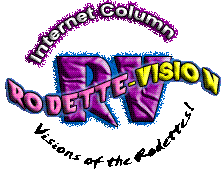
Ladies and Gentlemen, Boys and Girls, Children of ALL ages...Al's Place Proudly Brings you: Rodettevision...The Visions of Robyn X! Email Robyn X at: Tell her what you think at the Rod & Rodette-Vision Feedback Forum on our messageboard!
Return to the Archived RodetteVision Columns!
|
11-14-02 Welcome to Rodette-Vision! Where you get a woman’s point of view on Quantum Leap… Well, at least you get my point of view… hee hee…
Trivia: Last weeks Trivia was: What was Sam’s code word to bring Alia out of hypnosis? The answer: Rumplestiltskien Brian and Matt were the ones that had the correct answer!! Kudos to you two!! Since the Bartender now has his list of tricks… I think that I shall quit doing the Trivia. But I want to say thank you to those of you who have been answering them. =*=*=*=*=*=*=*=*=*=*=*=*= This weeks Rodette-Vision is going to be a tad bit different than in the past couple of weeks, and because of this, I will apologize beforehand. I know that it will be a long one… but bear with me. I do have a point in mind – and it’s all Quantum Leap related! Imagine that!!! This came to me yesterday as I looked at one of my kids’ homework. I couldn’t believe what they were making them do! ARCHETYPES!! ACK!! For those of you that don’t know what Archetypes are, well, let me get you the official definition as according to Webster’s. Archetypes: the original type, pattern or model of anything. So, the teacher gave them an assignment to watch TV and to look for Archetypes in the shows. Here’s the assignment: Using contemporary sources, give examples of the selected number of archetypes. Your sources may include movies, television series, comic strips, or contemporary fiction. Write one paragraph in which you explain why your source is an example of that particular archetype. You must be specific enough to prove you understand the archetype you are discussing. Each paragraph must follow the format given and will include the title of your source. The following archetypes are given for the students to look at: Character Archetypes: The Man Figure The Hero: the life of the protagonist can be clearly divided into a series of well-marked adventures. The Young Man from the Provinces: This hero is spirited away as a young man and raised by strangers. The Initiates: Young heroes or heroines who must endure some training and ceremony. The Mentor: These individuals serve as teachers or counselors to the heroes or heroines. The Mentor-Pupil Relationship: The mentor teaches the initiate the skills necessary to survive the quest. The Devil Figure: Evil incarnate, this character offers worldly goods, fame or knowledge for exchange for possession of soul. The Father-Son Conflict: Tension involved. Results from separation during childhood source when the individual meet as men where the mentor often has a higher place in the affections of the hero than a natural parent. The Outcast: A figure banished from a social group for some crime against his fellow man. Usually becomes a wanderer. The Scapegoat: An animal or human whose death in a public ceremony expiates some taint or sin that has been visited upon the community. The Star-Crossed Lovers: ill-fated love affair often ends tragically in death or either or both of the lovers. The Hunting Group of Companions: Loyal companions willing to face any number of perils in order to be together. The Loyal Retainers: These individuals are somewhat like servants who are heroic themselves. Their duty is to protect the hero and reflect the nobility of the hero. The Creature of Nightmare: A monster usually summoned from the deepest, darkest part of the human psyche to threaten the hero and/or heroine. The Friendly Beast: represents nature and shows nature to be on the side of the hero. The Apparently Evil Figure with an Ultimately Good Heart: redeemable devil figure saved by the nobility (or love) of the hero.
The Woman Figure The Damsel in Distress: The vulnerable woman who must be rescued by the hero. She is often used as a way to ensnare the hero. The Earthmother: Symbolic of fruition, abundance, and fertility, this character traditionally offers spiritual and emotional nourishment to those with whom she comes in contact. The Temptress: characterized by sensuous beauty, this woman is one to whom the protagonist is physically attracted and who ultimately brings about his downfall. The Platonic Ideal: This woman is a source of inspiration and spiritual ideal, for whom the protagonist or author has an intellectual rather a physical attraction. The Unfaithful Wife: This woman, married to a man she sees as dull and unimaginative, is physically attracted to a more virile and desirable man. Symbolic Archetypes Light – Darkness: Light usually suggests hope, renewal or intellectual illumination; darkness implies the unknown, ignorance or despair. Water – Desert: Because water is necessary to life and growth, it commonly appears as a birth or rebirth symbol. It is archetypally significant anthropologists believe. Conversely, the aridity of the desert is often associated with spiritual sterility and desiccation. Heaven – Hell: Man has traditionally associated parts of the universe not accessible to him with the dwelling places of the primordial forces that govern his world. The skies and mountaintops house his gods; the bowels of the earth contain the diabolic forces that inhabit his universe. Innate Wisdom vs. Educated Stupidity: Some of the characters exhibit wisdom and understanding of situations instinctively as opposed to those supposedly in charge. A hero often needs the guidance of innate wisdom. Supernatural Intervention: The gods intervene on the side of the hero or sometimes against him. Magic Weapon: This symbolizes the extraordinary quality of the hero because no one else can wield the weapon or use it to its full potential. It is usually given by a mentor figure. Haven – Wilderness: Places of safety contrast sharply against the dangerous wilderness. Heroes are often founding unexpected places. Wilderness threatens civilization.
Situational Archetypes The Quest: This motif describes the search for someone to some talisman which, when found and brought back, will restore fertility to a waster land, and the desolation of which is mirrored by a leader’s illness and disability. The Initiation: This usually takes the form of an initiation into life, that is, the depiction of an adolescent coming into maturity and adulthood with all the attendant problems and responsibilities that this process involves. An awakening awareness, or an increased perception of the world and the people in it usually form the climax. The Task: To save the kingdom, to win the fair lady, to identify himself so that he may reassume his rightful position, the hero must perform some nearly superhuman deed. The Ritual: The actual ceremonies that initiate experiences that will mark his rite of passage into another state. The Journey: Usually combined with any or all of the foregoing situational types; the journey is used to end the hero in search of information or some intellectual truth. A common employment of the journey is the descent into hell. A second is the depiction of limited number or travelers on a ride and using them as a microcosm of society. The Fall: describes a descent from a higher to a lower state of being. The experience involves spiritual defilement and/or a loss of innocence and bliss. Usually accompanied by expulsion from a kind of paradise as penalty for disobedience or moral transgression. Death and Rebirth: most common motif and grows out of the parallel between the cycle of nature and the cycle of life. Nature vs. The Mechanistic World: Nature is good while technology and society are often evil. The Battle Between Good and Evil: Obviously the battle between two primal forces. The Unhealable Wound: This wound is either physical or psychological and cannot be healed fully. This wound also indicates a loss of innocence. These wounds always ache and often drive the sufferer to desperate measures. NOW… that you know what each of these mean… How does all of this relate to Quantum Leap??? Well, if you haven’t already figured it out… THIS IS QUANTUM LEAP!!! Donald Bellasario must have gone through all of these and just written about them! It’s unbelievable. You can go through each of the Character Archetypes and see Sam, Al, or a character from the show. Just think about it. You have seen all of them at one point or another. I won’t go through them all but… Ex: The Friendly Beast – Bigfoot: Friendly enough to turn the truck completely around so that they could take the child to town. You get the idea. As for the Symbolic Archetypes: We’ve seen all of them as well. Ok… maybe not the Magic Weapon… that is unless you think of the handlink as a magic symbol; then maybe it could be. The one archetype that Bellasario had done so well was: Heaven-Hell. He’s shown us Sam’s heaven… and Alia’s Hell. He’s shown us pure evil and has portrayed it off most amazingly! Situational Archetypes: Same thing applies here. We have Sam’s Quest – to get back home. We see Sam’s Initiation through his leaps (trial after trial after trial). We have seen his Task of helping those throughout time. We have seen a Ritual through Q. L. and how Sam has come from his first leap… and how he’s grown. The Journey… and The Fall…. Enough said. Death and Rebirth – Cycle of Life… Giving a life for another life… MIA… wasn’t it? Nature vs Mechanistic World… an iffy… but it does fit in. The Unhealable Wound…. Emotionally longing for home… works here. And last but not the least, The Battle Between Good And Evil… "Putting things right that once went wrong…" Yes, I went in-depth on this. I couldn’t help myself. But… at least you can see all of the points that Bellasario and his writers were hitting on. It’s amazing… don’t you think? May peace, love and joy shine on you throughout your day and the rest of your week! Robyn X *~*~*~*~*~*~*~*~*~*~*~*~*~*~*~*~*~*~*~*~* Should you wish to email Robyn_X about this article or ANY Quantum Leap related matter, you can do so by contacting her at Robyn_X@hotmail.com |
